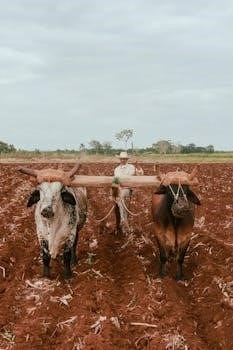Troy-Bilt Horse Tiller Manual⁚ A Comprehensive Guide
Welcome! This comprehensive guide provides information about the Troy-Bilt Horse Tiller Manual. Here‚ you will find resources‚ safety instructions‚ and maintenance tips. This guide helps you operate your tiller efficiently and safely. Ensuring optimal performance‚ it covers everything from troubleshooting to parts ordering.
The Troy-Bilt Horse Tiller is renowned for its durability and performance in gardens. This rear-tine tiller is a powerful tool for breaking ground and preparing soil. Understanding its operation is vital for efficient use. This section offers an introduction to this machine;
The Horse Tiller is designed for both homeowners and professionals. Its robust construction ensures long-lasting performance. Known for ease of use‚ it simplifies tilling tasks. Proper maintenance‚ as detailed in the manual‚ extends its life. This tiller handles various soil conditions effectively.
Safety is paramount when operating any machinery. Always adhere to safety guidelines in the manual. Familiarize yourself with controls before starting. Regular checks and adjustments are crucial. The Troy-Bilt Horse Tiller is a valuable tool for any gardener.
This guide provides essential information for maximizing your tiller’s capabilities. Refer to specific sections for detailed instructions. Whether you are a new user or experienced‚ this introduction ensures you’re prepared. Remember to consult the complete manual for comprehensive guidance and safety measures.
Finding Your Troy-Bilt Horse Tiller Manual
Locating the correct manual for your Troy-Bilt Horse Tiller is essential. This manual provides vital information for safe operation. Knowing where to find it ensures you can access it when needed. There are several options for obtaining your manual‚ both online and offline.
The first place to look is with your original purchase documents. Often‚ the manual is included in the packaging. If you no longer have these‚ check the Troy-Bilt website. They offer a digital library of manuals for various models. You’ll need your model number to find the correct one.
Another resource is online forums and communities. Many users share manuals and tips. Be sure to verify the manual’s authenticity before using it. Additionally‚ websites like ManualsOnline may have your manual available. Remember to download and save the manual for future reference.
If you prefer a hard copy‚ consider contacting Troy-Bilt customer support. They can provide a printed manual for a fee. Also‚ check with local equipment dealers. They might have access to older manuals. Having the manual at hand ensures you can maintain and repair your tiller effectively.
Free PDF Downloads of Manuals
Accessing your Troy-Bilt Horse Tiller manual as a PDF offers convenience. This allows you to view it on various devices. Downloading a free PDF version can save time and money. Several online resources provide these manuals at no cost. Knowing where to find these downloads is crucial.
Start by visiting the official Troy-Bilt website. They often have a section dedicated to manuals. Here‚ you can enter your tiller’s model number. This will lead you to the correct PDF manual for your specific model. Websites specializing in manuals‚ like ManualsOnline‚ are also useful.
Online forums and communities are another great resource. Users often share manuals they’ve found. Ensure the manual matches your tiller model before downloading. Be cautious of unofficial websites that might offer outdated or incorrect information. Always verify the source’s credibility.
Once you’ve located the PDF‚ download and save it to your computer or mobile device. This way‚ you can access it anytime‚ even without an internet connection. Keep a backup copy in case the original file gets corrupted. Having a digital manual makes it easier to search for specific instructions. It also allows you to print pages as needed.
Identifying Your Tiller Model and Serial Number
Locating your Troy-Bilt Horse Tiller’s model and serial number is essential. This information is needed for accessing the correct manual‚ ordering replacement parts‚ and seeking support. The model number identifies the specific type of tiller you own. The serial number is unique to your particular unit.
Typically‚ you can find the model and serial number on a sticker or plate attached to the tiller. Common locations include the engine housing‚ the frame near the wheels‚ or the rear of the tiller. Look for a label that clearly states “Model Number” and “Serial Number.” The format may vary slightly depending on the tiller’s age.
Once you’ve found the label‚ carefully note down both the model and serial number. Taking a picture with your phone is also a good idea. Keep this information in a safe place; This will save time when you need to reference it later.
The model number usually consists of a series of numbers and letters. The serial number is often a longer string of digits. If the label is damaged or unreadable‚ consult your original purchase documents. These documents often include the model and serial number. Contacting Troy-Bilt customer support is another option. Provide them with any information you have‚ and they may be able to help you identify your tiller.
Understanding the Operation Manual
The operation manual for your Troy-Bilt Horse Tiller is a vital resource. It provides detailed instructions on how to use and maintain your machine. This manual ensures safe and efficient operation. It is important to read the manual thoroughly before using the tiller for the first time.
The manual typically includes sections on assembly‚ starting procedures‚ and operating techniques. It also covers maintenance schedules‚ troubleshooting tips‚ and safety precautions. Familiarize yourself with the layout of the manual. Pay close attention to the diagrams and illustrations. These visual aids can help you understand complex procedures.
Pay special attention to the section on safety. This section outlines potential hazards and how to avoid them. Always follow the safety guidelines to prevent accidents and injuries. The manual also includes information on adjusting the tiller for different soil conditions. Understanding these adjustments will help you achieve optimal tilling performance.
The troubleshooting section can help you diagnose and fix common problems. Before attempting any repairs‚ consult this section. The manual also provides information on ordering replacement parts. Use the part numbers listed in the manual when ordering to ensure you get the correct components. Keep the operation manual in a safe and accessible place for future reference.
Safety Instructions and Warnings
Prioritize safety when operating your Troy-Bilt Horse Tiller. Always read and understand all safety instructions and warnings provided in the manual before operation. Failure to comply may result in serious personal injury. Never allow children or untrained individuals to operate the tiller. Ensure all operators are thoroughly familiar with the controls and safety features.
Wear appropriate personal protective equipment (PPE) when operating the tiller‚ including safety glasses‚ sturdy footwear‚ and hearing protection. Avoid loose clothing or jewelry that could get caught in moving parts. Before starting the tiller‚ inspect the area for obstacles such as rocks‚ roots‚ or debris. Clear the area to prevent damage to the tiller and reduce the risk of injury.

Keep bystanders and pets away from the operating area. Never operate the tiller on slopes or uneven terrain where you could lose control. Be aware of underground utilities and avoid tilling in areas where they may be present. Always stop the engine and disconnect the spark plug wire before performing any maintenance or repairs.
Never operate the tiller in enclosed spaces or poorly ventilated areas to avoid carbon monoxide poisoning. Store fuel in a well-ventilated area away from heat sources and open flames. Regularly inspect the tiller for any signs of damage or wear. Replace worn or damaged parts immediately. Following these safety instructions will help ensure a safe and productive tilling experience.
Maintenance and Adjustments
Regular maintenance and adjustments are crucial for ensuring the longevity and optimal performance of your Troy-Bilt Horse Tiller. Consult your manual for specific maintenance schedules and procedures. Before performing any maintenance‚ always stop the engine‚ remove the spark plug wire‚ and allow the tiller to cool down completely.
Check the engine oil level before each use and change the oil according to the manual’s recommendations. Keep the air filter clean to ensure proper engine performance. Inspect the tines regularly for wear and damage. Replace worn or damaged tines to maintain efficient tilling. Adjust the tine depth according to the soil conditions and desired tilling depth.
Check and adjust the belt tension as needed to prevent slippage and ensure proper power transmission. Lubricate all moving parts regularly with a high-quality grease to reduce friction and wear. Inspect the tires for proper inflation and signs of damage. Adjust the carburetor as needed to maintain optimal engine performance.
Check the spark plug condition and replace it if necessary. Clean the cooling fins on the engine to prevent overheating. Store the tiller in a dry‚ protected area when not in use. Following these maintenance and adjustment procedures will help keep your Troy-Bilt Horse Tiller in top condition and extend its lifespan. Always refer to your manual for detailed instructions and specific recommendations.
Battery Installation and Charging (Electric Start Models)

For Troy-Bilt Horse Tiller models equipped with electric start‚ proper battery installation and charging are essential for reliable operation. Always refer to your specific model’s operation manual for detailed instructions and safety precautions. Before installing the battery‚ ensure the tiller is turned off and the spark plug wire is disconnected.
Locate the battery compartment‚ typically near the engine. Connect the positive (+) battery cable to the positive terminal and the negative (-) cable to the negative terminal. Ensure the connections are secure and corrosion-free. Use a battery charger that is compatible with the battery type specified in your manual.
Follow the charger’s instructions carefully to avoid overcharging or damaging the battery. Charge the battery fully before the first use and maintain a full charge during periods of inactivity. Regularly check the battery terminals for corrosion and clean them with a wire brush and a solution of baking soda and water.
Proper battery maintenance will prolong its life and ensure reliable starting. If the battery is not holding a charge‚ it may need to be replaced. Dispose of old batteries properly according to local regulations. Always wear safety glasses and gloves when handling batteries to protect against acid spills. Following these guidelines will help you maintain a healthy battery for your electric start Troy-Bilt Horse Tiller.
Loading and Unloading the Tiller

When transporting your Troy-Bilt Horse Tiller‚ proper loading and unloading techniques are crucial for safety and preventing damage. Before loading‚ ensure the tiller is turned off and the engine has cooled down. Disconnect the spark plug wire to prevent accidental starting. Inspect the ramps and trailer or truck bed to ensure they are sturdy and capable of supporting the tiller’s weight.
Position the ramps securely against the trailer or truck bed‚ ensuring they are properly aligned and won’t slip during loading or unloading. Engage the tiller’s wheel speed lever to “FREEWHEEL” if possible‚ making it easier to push manually. If the tiller is heavy‚ consider using a winch or come-along to assist with loading. Slowly and carefully push or pull the tiller up the ramps‚ maintaining control at all times.
Once the tiller is on the trailer or truck bed‚ secure it with straps or chains‚ ensuring it cannot move during transport. Distribute the weight evenly and avoid placing excessive stress on any single point. When unloading‚ follow the same procedures in reverse. Ensure the area is clear of obstacles and people. Slowly guide the tiller down the ramps‚ maintaining control.
After unloading‚ inspect the tiller for any damage that may have occurred during transport. Store the tiller in a safe and dry location. Always consult your Troy-Bilt Horse Tiller manual for specific loading and unloading instructions and safety recommendations.
Troubleshooting Common Issues
Encountering issues with your Troy-Bilt Horse Tiller can be frustrating‚ but many problems can be resolved with basic troubleshooting. If the engine fails to start‚ check the fuel level‚ spark plug condition‚ and air filter. Ensure the fuel valve is open and the spark plug wire is securely connected. A dirty air filter can restrict airflow‚ preventing the engine from starting. Clean or replace the air filter as needed.
If the tiller starts but runs poorly‚ check the carburetor for clogs or debris. A clogged carburetor can disrupt the fuel-air mixture‚ leading to rough running or stalling. Clean the carburetor or consider using a fuel stabilizer to prevent future clogs; If the tines do not rotate‚ inspect the belt or chain that drives them. A worn or broken belt or chain will need to be replaced;
Check the tine engagement lever and cable for proper adjustment. If the tiller vibrates excessively‚ check the tines for damage or imbalance. Replace any damaged tines and ensure they are properly installed. If the wheels do not move‚ check the wheel speed lever and cable for proper adjustment. Ensure the wheels are not obstructed by debris or tangled material.
Consult your Troy-Bilt Horse Tiller manual for detailed troubleshooting steps and diagrams. If you are unable to resolve the issue yourself‚ contact a qualified service technician for assistance. Regular maintenance and timely repairs will help keep your tiller running smoothly for years to come.
Parts Diagrams and Catalogs
Understanding the anatomy of your Troy-Bilt Horse Tiller is essential for effective maintenance and repair. Parts diagrams and catalogs provide detailed visual representations and listings of all components‚ enabling you to identify and locate the specific parts you need. These resources are invaluable when troubleshooting issues or performing routine maintenance.
Parts diagrams typically illustrate the tiller’s various systems‚ such as the engine‚ transmission‚ tines‚ and wheels‚ with each part labeled and numbered. Catalogs provide detailed descriptions‚ part numbers‚ and compatibility information. Using these tools‚ you can accurately identify the correct replacement parts for your specific tiller model.
Many online resources offer downloadable parts diagrams and catalogs for Troy-Bilt Horse Tillers. These digital versions often include interactive features‚ allowing you to zoom in on specific areas and click on individual parts to view their details. Alternatively‚ you can obtain printed copies from Troy-Bilt dealers or online retailers.
When using parts diagrams and catalogs‚ be sure to verify that the information matches your tiller’s model and serial number. This will ensure that you order the correct parts and avoid compatibility issues. Keep these resources readily accessible for future reference‚ as they can save you time and effort when performing maintenance or repairs.
Ordering Replacement Parts
Once you’ve identified the necessary replacement parts using the parts diagrams and catalogs‚ the next step is to order them. Several options are available for purchasing replacement parts for your Troy-Bilt Horse Tiller‚ each with its own advantages; Ordering directly from Troy-Bilt ensures that you receive genuine‚ high-quality parts specifically designed for your tiller.

You can visit the official Troy-Bilt website or contact their customer support department to place an order. Authorized Troy-Bilt dealers also offer a wide selection of replacement parts and can provide expert assistance in identifying the correct components. These dealers often have knowledgeable staff who can answer your questions and offer guidance on installation.
Online retailers‚ such as Amazon and eBay‚ provide another avenue for purchasing replacement parts. However‚ it’s crucial to verify the seller’s reputation and ensure that the parts are genuine Troy-Bilt products. When ordering online‚ carefully review the product description and customer reviews to avoid purchasing counterfeit or incompatible parts.
Before placing your order‚ double-check the part numbers and quantities to ensure accuracy. Consider purchasing commonly used parts‚ such as belts‚ blades‚ and filters‚ in advance to have them on hand for routine maintenance. Keep records of your orders and receipts for future reference.
